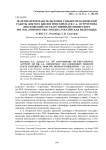Самарская Лука: проблемы региональной и глобальной экологии @ssc-sl
Статьи журнала - Самарская Лука: проблемы региональной и глобальной экологии
Все статьи: 1477

"Гора с горой не сходится, а горшок с горшком столкнётся". Геннадий Розенберг против Греты Тунберг
Другой
Эссе посвящено экологическим проблемам, которые встанут перед человечеством после завершения пандемии COVID-19.
Бесплатно

"Зеленые бастионы" Нестора Генко
Другой
Описывается жизнь и деятельность великого лесовода Нестора Карловича Генко.
Бесплатно

"Принц жигулевский" (к юбилею Сергея Владимировича Саксонова)
Персоналии
В статье приводятся основные заслуги С.В. Саксонова.
Бесплатно

"Слияние" и "поглощение" - два пути объединения
Другой
Обсуждаются различные аспекты («за» и «против», технологические принципы, модели и пр.) объединения высших учебных заведений страны.
Бесплатно

2017 год в гербарии PVB: итоги полевого сезона
Краткое сообщение
Подведены итоги работы гербария PVB за 2017 год. Показано количество сборов по различным регионам РФ, поступивших в гербарный фонд за прошедший год в результате поведенных экспедиционных исследований.
Бесплатно

Персоналии
Статья посвящена 30-летиют преподавательской и учебно-методической деятельности ведущего научного сотрудника Московского государственного университета им. М.В. Ломоносова, члена редсовета журнала «Самарская Лука: проблемы региональной и глобальной экологии» доктора биологических наук С.А. Остроумова.
Бесплатно

Asteraceae во флоре Среднего Поволжья
Статья научная
В статье приведен аннотированный список видов семейства Asteraceae (Compositae) флоры Среднего Поволжья (в пределах Мордовии, Татарстана, Чувашии, Пензенской, Самарской, Ульяновской областей). В нем пронумеровано 305 видов (аборигенных, ненамеренно-заносных и интродуцентов, встречающихся вне культуры), а также указаны без номеров 77 видов интродуцентов, известных только в культуре, 30 гибридов (нотовидов), 41 микровид рода Taraxacum и 31 вид, нуждающийся в подтверждении сведений о произрастании в регионе. Два вида занесены в Перечень Красной книги РФ: Archanthemis trotzkiana [ Anthemis trotzkiana ] и Klasea tanaitica [ K. radiata subsp. tanaitica ; Serratula tanaitica ].
Бесплатно

Biological factors in control of water quality
Статья научная
Generalizations presented in this paper represent, in a systematized form, the basic elements of the qualitative theory of biotic control of water quality and water self-purification in freshwater and marine ecosystems. The theory contributes to a better understanding of the issues of stability and regulation in the biosphere. The theory is supported by the results of the author’s experimental studies of the effects exerted by surfactants, detergents and other pollutants on aquatic organisms.
Бесплатно

Статья научная
Essential oils, which including terpenoids, phenolic compounds, and other volatiles of Majorana syriaca leaves growing wild in Palestine were analyzed using static headspace gas chromatography mass spectrometry technique (HS-GCMS) to check for their chemical variability. The samples were collected from thirty-four individual plants naturally growing in different locations from Palestine. In such a small-restricted area, a wide range of variation in oil characteristics was observed indicating that the Palestinian region is an important center of diversity. The essential oil yield, based on air-dried weight, ranged from 10.5-mg g-1 to 54-mg g-1. The major constituents identified throughout all the harvesting periods were varied greatly among the samples examined. HS revealed major volatiles and semi-volatiles of α-phellandrene (1.62-8.13%), α-pinene (1.22-4.61%), β-myrecene (0.5-11%), m-cymene (1.86-8.61%), p-cymene (8.44-48.6%), γ-terpinene (11.96-30.8%), thymol (0.26-11.6%), and carvacrol (0.65-21.7%). As for the phenolic compounds, the results revealed that the wild growing Majorana syriaca could be characterized by the dominant presence of carvacrol. Conversely, water irrigation has showed a prominent effect on the thymol isomer production. Therefore, we suggest using isomeric distribution ratios of these isomers as a marker to distinguish wild from cultivated Majorana syriaca.
Бесплатно

Краткое сообщение
В статье обсуждаются результаты наблюдений за состоянием ценопопуляции Epipactis helleborine. Представлены эколого-биологические аспекты изученного вида.
Бесплатно











